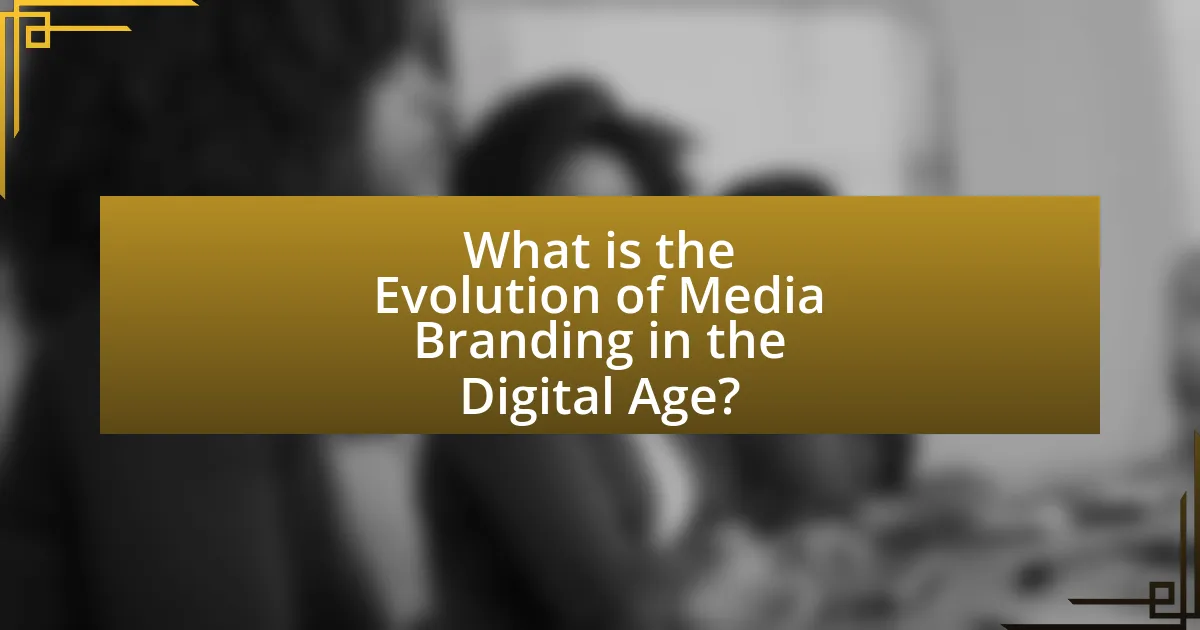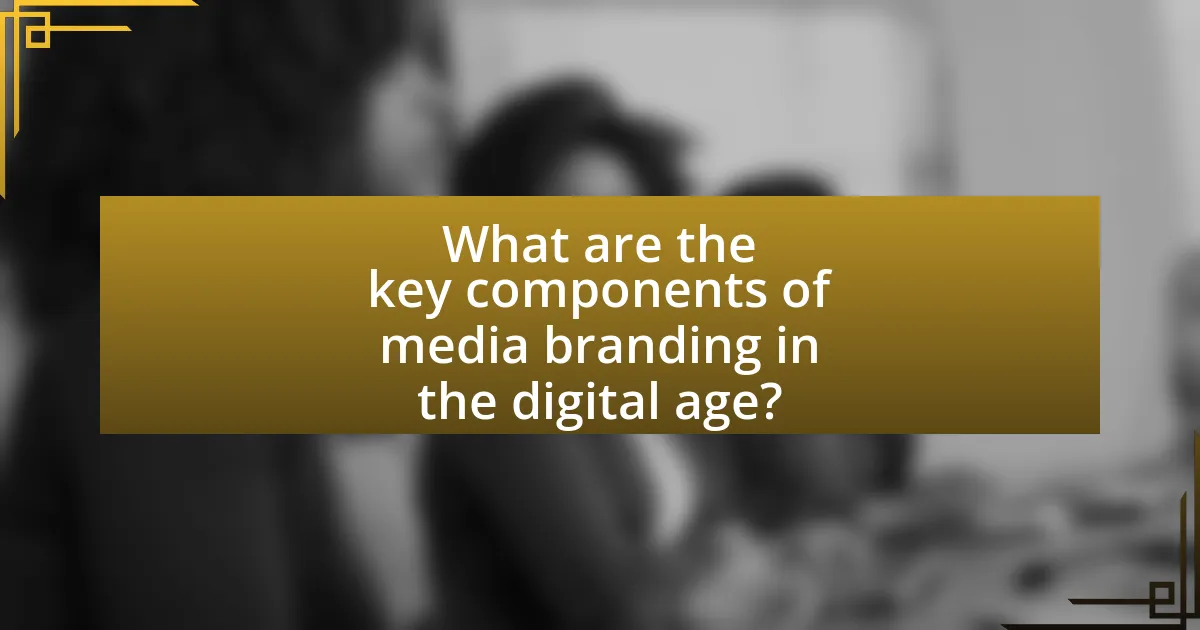The article examines the evolution of media branding in the digital age, highlighting the transition from traditional one-way communication to interactive, multi-channel engagement facilitated by social media and data analytics. It outlines key milestones in media branding, including the rise of print, radio, television, and digital platforms, emphasizing the importance of audience engagement and personalized strategies. The discussion also covers the impact of digital technologies, challenges brands face, and best practices for maintaining a cohesive brand identity across various platforms, ultimately underscoring the significance of understanding media branding in today’s competitive landscape.

What is the Evolution of Media Branding in the Digital Age?
The evolution of media branding in the digital age involves a shift from traditional, one-way communication to interactive, multi-channel engagement. This transformation is driven by the rise of social media platforms, which allow brands to connect directly with consumers, fostering a two-way dialogue. According to a 2021 report by Statista, over 4.2 billion people globally use social media, highlighting its significance in brand visibility and consumer interaction. Additionally, the integration of data analytics enables brands to tailor their messaging and strategies based on consumer behavior, enhancing personalization and relevance. This evolution reflects a broader trend where brands must adapt to rapidly changing technologies and consumer expectations to maintain their competitive edge.
How has media branding changed with the advent of digital technology?
Media branding has transformed significantly with the advent of digital technology, shifting from traditional, one-way communication to interactive, multi-channel engagement. This change allows brands to connect with audiences through social media, websites, and mobile applications, fostering real-time feedback and personalized experiences. For instance, according to a 2021 report by Statista, 54% of consumers prefer brands that engage with them on social media, highlighting the importance of digital interaction in modern branding strategies. Additionally, digital analytics enable brands to track consumer behavior and preferences, allowing for targeted marketing efforts that were not possible in the pre-digital era.
What are the key milestones in the evolution of media branding?
The key milestones in the evolution of media branding include the establishment of print media in the 15th century, the advent of radio and television in the 20th century, and the rise of digital media in the 21st century. The introduction of print media allowed for the first branded publications, creating a foundation for brand identity. The emergence of radio and television introduced audio-visual branding, enabling brands to reach wider audiences through storytelling and advertising. The digital age has transformed media branding further, with social media platforms and online content allowing for real-time engagement and personalized branding strategies. These milestones illustrate the progression from traditional to digital branding, highlighting the increasing importance of audience interaction and adaptability in media branding strategies.
How do digital platforms influence media branding strategies?
Digital platforms significantly influence media branding strategies by enabling targeted audience engagement and real-time feedback. These platforms allow brands to analyze user data, which informs content creation and distribution, ensuring that messaging resonates with specific demographics. For instance, a study by the Pew Research Center found that 72% of adults use social media, highlighting the importance of these platforms in reaching a broad audience. Additionally, brands can leverage algorithms on platforms like Facebook and Instagram to optimize visibility and engagement, leading to more effective branding outcomes.
Why is understanding media branding important in today’s digital landscape?
Understanding media branding is crucial in today’s digital landscape because it shapes audience perception and engagement. In an era where consumers are bombarded with content across multiple platforms, effective media branding helps differentiate a brand from competitors, fostering loyalty and trust. According to a 2021 study by Nielsen, 59% of consumers prefer to buy new products from brands familiar to them, highlighting the importance of brand recognition. Furthermore, consistent branding across digital channels can increase revenue by up to 23%, as reported by Forbes. This demonstrates that a strong media brand not only attracts attention but also drives financial success in a crowded marketplace.
What role does media branding play in audience engagement?
Media branding significantly enhances audience engagement by creating a recognizable identity that fosters trust and loyalty. A strong media brand communicates consistent values and messages, which helps audiences form emotional connections. Research indicates that 64% of consumers cite shared values as the primary reason they have a relationship with a brand, demonstrating that effective media branding can lead to deeper audience involvement. Furthermore, brands that engage in storytelling and maintain a cohesive visual identity are more likely to capture and retain audience attention, as evidenced by studies showing that storytelling can increase audience retention by up to 22 times.
How does media branding impact brand loyalty in the digital age?
Media branding significantly enhances brand loyalty in the digital age by creating a consistent and engaging identity across various platforms. This consistency fosters trust and recognition among consumers, leading to stronger emotional connections with the brand. Research indicates that 64% of consumers cite shared values as the primary reason for their loyalty to a brand, highlighting the importance of media branding in aligning brand messaging with consumer beliefs. Furthermore, brands that effectively utilize social media to engage with their audience see a 20-40% increase in customer retention rates, demonstrating the direct correlation between media branding efforts and brand loyalty.

What are the key components of media branding in the digital age?
The key components of media branding in the digital age include a strong online presence, audience engagement, content strategy, and data analytics. A strong online presence is essential as it establishes visibility across various digital platforms, allowing brands to reach wider audiences. Audience engagement is crucial for building relationships and fostering loyalty, often achieved through interactive content and social media interactions. A well-defined content strategy ensures that messaging is consistent and resonates with target demographics, while data analytics provides insights into audience behavior and preferences, enabling brands to refine their strategies effectively. These components collectively enhance brand recognition and influence in the digital landscape.
How do social media platforms contribute to media branding?
Social media platforms significantly contribute to media branding by providing a direct channel for engagement and interaction between brands and their audiences. These platforms enable brands to share content, promote their identity, and foster community through user-generated content and feedback. For instance, according to a 2021 report by Hootsuite, 54% of social media users utilize these platforms to research products, indicating that social media is a critical touchpoint in the consumer decision-making process. Additionally, brands can leverage targeted advertising on platforms like Facebook and Instagram to reach specific demographics, enhancing brand visibility and recognition. This targeted approach is supported by data from Statista, which shows that social media ad spending is projected to reach over $200 billion by 2023, underscoring the importance of these platforms in shaping brand perception and loyalty.
What strategies can brands use on social media for effective branding?
Brands can use targeted content creation, audience engagement, and data analytics as effective strategies on social media for branding. Targeted content creation involves producing tailored posts that resonate with specific demographics, enhancing relevance and connection. Audience engagement, through interactive elements like polls and Q&A sessions, fosters community and loyalty, which are crucial for brand identity. Data analytics allows brands to track performance metrics, enabling them to refine strategies based on audience behavior and preferences. According to a 2021 report by Hootsuite, brands that actively engage with their audience see a 20% increase in customer loyalty, demonstrating the effectiveness of these strategies in building a strong brand presence on social media.
How do influencers shape media branding in the digital space?
Influencers shape media branding in the digital space by leveraging their personal brands to create authentic connections with audiences, which enhances brand visibility and credibility. Their ability to engage followers through social media platforms allows brands to reach targeted demographics effectively. For instance, a study by the Digital Marketing Institute found that 49% of consumers depend on influencer recommendations when making purchasing decisions, demonstrating the significant impact influencers have on consumer behavior and brand perception. This relationship between influencers and brands fosters a more relatable and trustworthy image, ultimately driving brand loyalty and sales.
What technologies are driving the evolution of media branding?
Artificial intelligence, social media platforms, and data analytics are driving the evolution of media branding. Artificial intelligence enables personalized content delivery and enhances user engagement through targeted advertising. Social media platforms facilitate direct interaction between brands and consumers, allowing for real-time feedback and community building. Data analytics provides insights into consumer behavior, enabling brands to tailor their strategies effectively. For instance, a report by Statista indicates that 79% of marketers believe that data-driven marketing is crucial for success, highlighting the importance of these technologies in shaping modern media branding.
How does data analytics enhance media branding efforts?
Data analytics enhances media branding efforts by providing insights into audience behavior and preferences, enabling brands to tailor their messaging and content effectively. By analyzing data from various sources, such as social media interactions and website traffic, brands can identify trends and patterns that inform their marketing strategies. For instance, a study by McKinsey & Company found that companies leveraging data analytics in their branding efforts can achieve a 15-20% increase in marketing effectiveness. This data-driven approach allows brands to optimize their campaigns, improve customer engagement, and ultimately strengthen their brand identity in a competitive digital landscape.
What role does artificial intelligence play in media branding?
Artificial intelligence plays a crucial role in media branding by enabling personalized content delivery and enhancing audience engagement. AI algorithms analyze user data to tailor marketing strategies, ensuring that brands reach their target demographics effectively. For instance, a study by McKinsey & Company found that companies using AI for marketing saw a 10-20% increase in sales due to improved customer targeting and engagement. This demonstrates that AI not only streamlines branding efforts but also significantly boosts brand visibility and consumer loyalty in the digital landscape.

What challenges do brands face in media branding today?
Brands face significant challenges in media branding today, primarily due to the rapid evolution of digital platforms and changing consumer behaviors. The proliferation of social media has led to increased competition for consumer attention, making it difficult for brands to stand out. Additionally, the rise of ad-blocking technologies has reduced the effectiveness of traditional advertising methods, forcing brands to adapt their strategies. According to a 2022 report by eMarketer, 27% of internet users in the U.S. use ad blockers, highlighting the urgency for brands to innovate their media branding approaches. Furthermore, maintaining brand authenticity and trust has become crucial, as consumers increasingly demand transparency and ethical practices from brands. This shift necessitates a more nuanced understanding of audience engagement and content creation, complicating the media branding landscape for companies.
How do changing consumer behaviors affect media branding?
Changing consumer behaviors significantly impact media branding by necessitating brands to adapt their strategies to meet evolving preferences and expectations. As consumers increasingly prioritize personalized experiences and authenticity, media brands must leverage data analytics to tailor content and messaging effectively. For instance, a 2021 study by McKinsey & Company found that 71% of consumers expect companies to deliver personalized interactions, highlighting the need for brands to shift from traditional one-size-fits-all approaches to more targeted strategies. This shift not only enhances consumer engagement but also fosters brand loyalty, as consumers are more likely to connect with brands that resonate with their values and lifestyles.
What are the implications of short attention spans on media branding?
Short attention spans significantly impact media branding by necessitating concise and engaging content to capture audience interest quickly. Brands must adapt their messaging strategies to deliver key information within seconds, often utilizing visually appealing formats and interactive elements to maintain engagement. Research indicates that the average human attention span has decreased to about eight seconds, which compels brands to prioritize clarity and immediacy in their communications. Consequently, brands that fail to adapt risk losing audience engagement and market relevance, as consumers increasingly favor content that is easily digestible and quickly accessible.
How can brands adapt to the rise of ad-blocking technologies?
Brands can adapt to the rise of ad-blocking technologies by focusing on creating high-quality, engaging content that provides value to consumers. This approach shifts the emphasis from traditional advertising to content marketing, which has been shown to be more effective in reaching audiences who use ad blockers. According to a study by the Content Marketing Institute, 70% of consumers prefer to learn about a company through articles rather than ads, indicating a clear preference for informative content over intrusive advertising. By investing in native advertising, personalized marketing strategies, and building strong relationships with their audience, brands can effectively navigate the challenges posed by ad-blocking technologies.
What ethical considerations arise in media branding in the digital age?
Ethical considerations in media branding in the digital age include issues of transparency, data privacy, and representation. Media brands must ensure that their messaging is honest and not misleading, as consumers increasingly demand authenticity. Additionally, the collection and use of personal data for targeted advertising raise significant privacy concerns, necessitating adherence to regulations like GDPR. Furthermore, representation in media branding must reflect diversity and avoid perpetuating stereotypes, as brands are held accountable for their social impact. These considerations are critical as they influence consumer trust and brand loyalty in a highly connected digital landscape.
How can brands ensure transparency in their media branding efforts?
Brands can ensure transparency in their media branding efforts by openly sharing their advertising practices, data usage policies, and the criteria for selecting media partners. This approach builds trust with consumers, as evidenced by a 2021 study from the American Marketing Association, which found that 78% of consumers are more likely to engage with brands that are transparent about their marketing strategies. Additionally, brands can utilize third-party audits and certifications to validate their claims, further enhancing credibility and accountability in their media branding initiatives.
What are the risks of misinformation in media branding?
Misinformation in media branding poses significant risks, including damage to brand reputation, loss of consumer trust, and potential legal repercussions. When brands disseminate false or misleading information, they can alienate their audience, leading to a decline in customer loyalty and sales. For instance, a study by the Pew Research Center found that 64% of Americans believe that misinformation has caused confusion about basic facts, which can directly impact how consumers perceive and engage with brands. Additionally, brands may face legal challenges if misinformation leads to consumer harm or violates advertising standards, as seen in cases where companies have been sued for false advertising claims. These risks highlight the critical importance of accuracy and transparency in media branding strategies.
What best practices can brands adopt for effective media branding?
Brands can adopt several best practices for effective media branding, including maintaining a consistent brand voice, leveraging data analytics, and engaging with audiences through interactive content. Consistency in brand voice across all media platforms helps establish recognition and trust, as seen in successful brands like Coca-Cola, which maintains a uniform message and aesthetic. Utilizing data analytics allows brands to understand audience preferences and tailor content accordingly, enhancing engagement; for instance, Netflix uses viewer data to inform its content strategy. Additionally, interactive content, such as polls and quizzes, fosters audience participation and strengthens brand loyalty, as evidenced by brands like BuzzFeed that effectively use this approach to engage users.
How can brands create a cohesive brand identity across digital platforms?
Brands can create a cohesive brand identity across digital platforms by ensuring consistent messaging, visual elements, and user experience. Consistency in logos, color schemes, and typography across websites, social media, and advertising reinforces brand recognition. Research indicates that consistent branding can increase revenue by up to 23% (Lucidpress, 2019). Additionally, brands should develop a unified voice and tone in their communications, which helps in building trust and familiarity with the audience. By integrating these elements, brands can effectively maintain a cohesive identity that resonates across various digital channels.
What are the key metrics for measuring success in media branding?
Key metrics for measuring success in media branding include brand awareness, engagement rates, audience reach, and conversion rates. Brand awareness can be quantified through surveys and social media mentions, indicating how well the target audience recognizes the brand. Engagement rates, measured through likes, shares, and comments on social media platforms, reflect how actively the audience interacts with the brand’s content. Audience reach assesses the total number of unique users exposed to the brand’s messaging, often tracked through analytics tools. Conversion rates, which measure the percentage of users who take a desired action, such as making a purchase or signing up for a newsletter, provide insight into the effectiveness of branding efforts in driving business outcomes. These metrics collectively offer a comprehensive view of a brand’s performance in the media landscape.

Leave a Reply